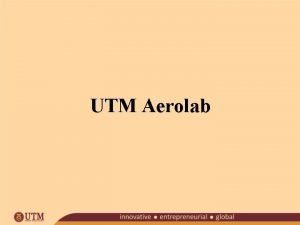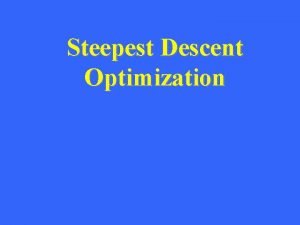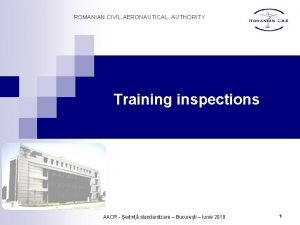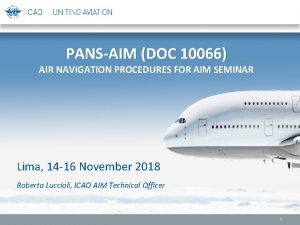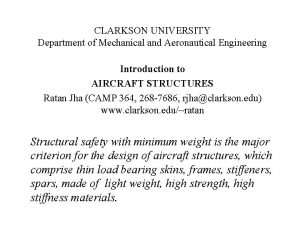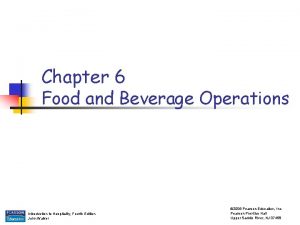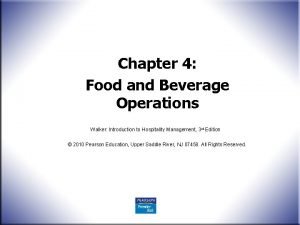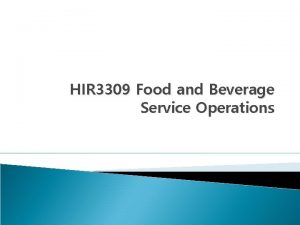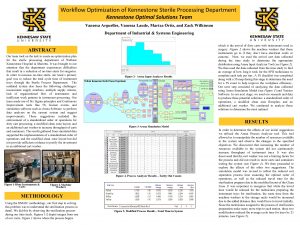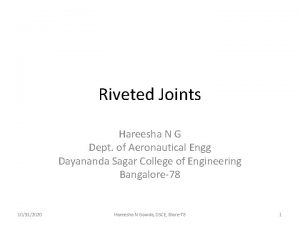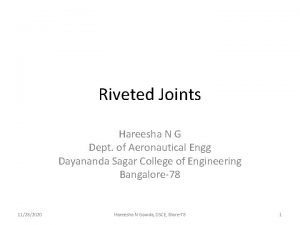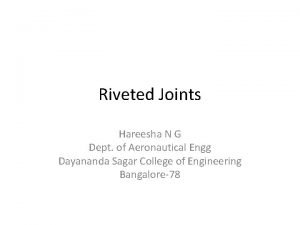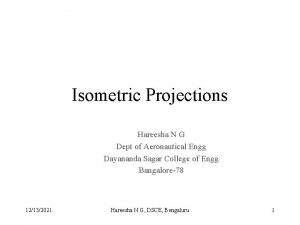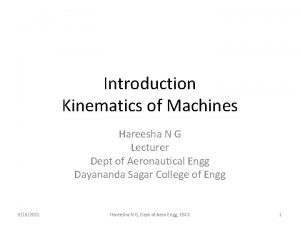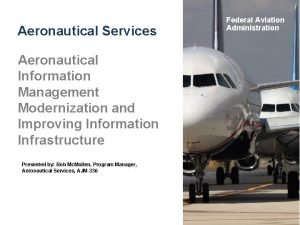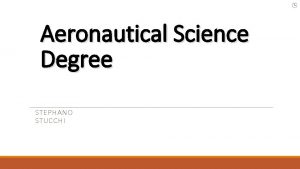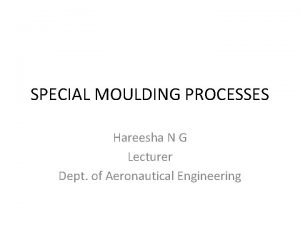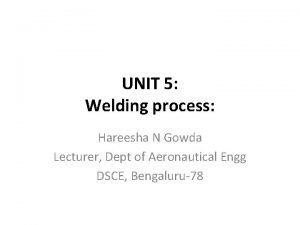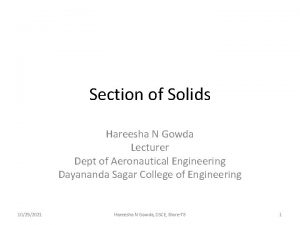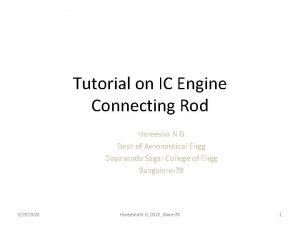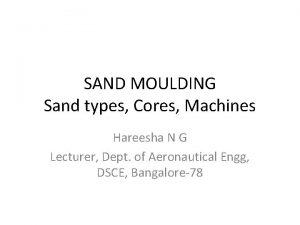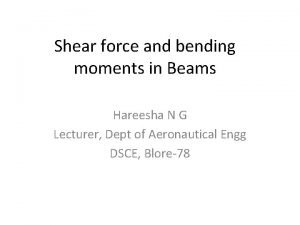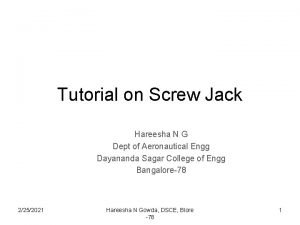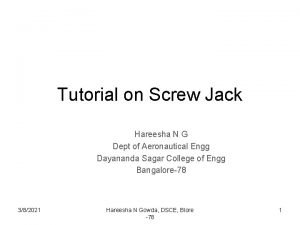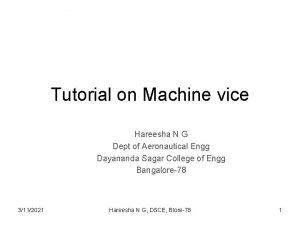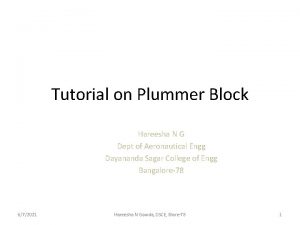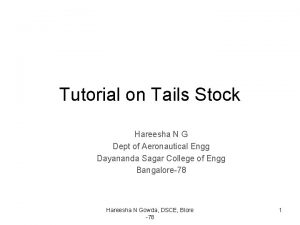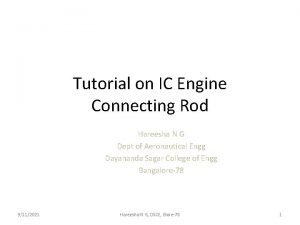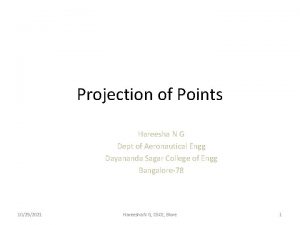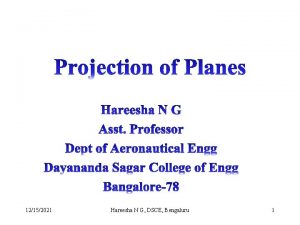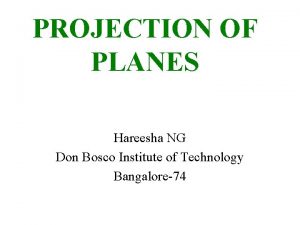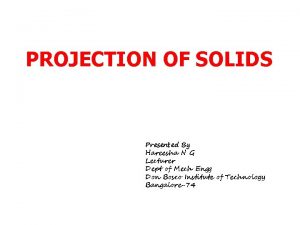INTRODUCTION Hareesha N G Lecturer Department of aeronautical








































- Slides: 40

INTRODUCTION Hareesha N G Lecturer Department of aeronautical engg

Classification of manufacturing process Hareesha N G Dept Aero Engg, DSCE, Blore 2

Classification of manufacturing process Hareesha N G Dept Aero Engg, DSCE, Blore 3

Types of production systems • Mass production / continuous flow process • Batch production • Job shop production Hareesha N G Dept Aero Engg, DSCE, Blore 4

Sand casting Hareesha N G Dept Aero Engg, DSCE, Blore 5

Sand casting Hareesha N G Dept Aero Engg, DSCE, Blore 6

Rolling Hot-rolling Cold-rolling Hareesha N G Dept Aero Engg, DSCE, Blore 7

Factors to be considered for selecting a production process a) Shape and size to be produced - For products with simple shape, machining is best suited. But for complex and intricate shapes, casting is preferred. The size of the product is also an important factor. For example, 'long' products such as rails or 'thin' products such as car-body panels can be best made by forming process compared to others. (b) Quantity to be produced - Both machining and casting can be used for producing large quantity products, but are not suitable for small quantity products, as they are not economical. (c) Type of material - Materials possess various properties like ductility, hardness, toughness, brittleness etc. Hard materials cannot be machined easily. Brittle materials cannot be mechanically worked (Forming process). In such cases, casting is preferred. Hareesha N G Dept Aero Engg, DSCE, Blore 8

Factors to be considered for selecting a production process (d) Surface finish and dimensional accuracy - Casting with expendable moulds does not yield good surface finish. However, " if casting process is selected, it should be followed by machining process to obtain the desired surface finish and dimensional tolerance. (e) Quality and property requirements - A defect-free product with specific properties serve its purpose for long life. Properties of cast material are generally less when compared to that of mechanically worked materials. Also, casting gives a lot of defects. Hence, a process that gives better properties and quality should be selected. (f) Cost of the product - Customers often demand for products with more features and performance at reduced prices. Hence, a low cost production process should be selected, but at the same time, see that no compromise is made in terms of quality. Hareesha N G Dept Aero Engg, DSCE, Blore 9

CASTING PROCESS Hareesha N G Dept Aero Engg, DSCE, Blore 10

Terms involved in casting Hareesha N G Dept Aero Engg, DSCE, Blore 11

Terms involved in casting process • Mould box (flask) : It is usually a metallic frame used for making and holding a sand mould. The mould box has two parts: the upper part called 'cope', and the lower part called 'drag'. • Parting line/parting surface: It is the zone of separation between cope and drag portions of the mould in sand casting. • Sprue: It is vertical passage through which the molten metal will enter the gate. • Pouring basin: The enlarged portion of the sprue at its top into which the molten metal is poured. Hareesha N G Dept Aero Engg, DSCE, Blore 12

Terms involved in casting process • Gate/ingate: It is a short passage way which carries the molten metal from the runner/ sprue into the mould cavity. • Riser: A riser or feed-head is a vertical passage that stores the molten metal and supplies (feed) the same to the casting as it solidifies. • Mould cavity: The space in a mould that is filled with molten metal to form the casting upon solidification. • Core: A core is a pre-formed (shaped) mass of sand placed in the mould cavity to form hollow cavities in castings. • Core print: It is a projection attached to the pattern to help for support and correct location of core in the mould cavity. Hareesha N G Dept Aero Engg, DSCE, Blore 13

STEPS INVOLVED IN MAKING A CASTING The basic steps in making a casting are: (a) (b) (c) (d) (e) Pattern making Mould preparation (including gating and risering) Core making Melting and Pouring Cleaning and Inspection Hareesha N G Dept Aero Engg, DSCE, Blore 14

a) Pattern making • A pattern is a replica of the object to be cast. • It is used to prepare a cavity into which the molten metal is poured. • A skilled pattern maker prepares the pattern using wood, metal, plastic or other materials with the help of machines and special tools. • Many factors viz. , durability, allowance for shrinkage and machining etc. , are considered while making a pattern. Hareesha N G Dept Aero Engg, DSCE, Blore 15

b) Mould preparation • Mould preparation involves forming a cavity by packing sand around a pattern enclosed in a supporting metallic frame called 'flask' (mould box). • When the pattern is removed from the mould, an exact shaped cavity remains into which the molten metal is poured. • Gating and risering are provided at suitable locations in the mould. – Gating - Passage through which molten metal flows and enter the mould cavity. – Risering - A reservoir of molten metal connected to the mould cavity to supply additional metal so as to compensate for losses due to shrinkage, as the metal solidifies. Hareesha N G Dept Aero Engg, DSCE, Blore 16

c) Core making • In some cases, a hole or cavity is required in the casting. • This is obtained by placing a core in the mould cavity. • The shape of the corresponds to the shape of the hole required. Hareesha N G Dept Aero Engg, DSCE, Blore 17

d) Melting and Pouring • Metals or alloys of the required composition are melted in a furnace and poured into the mould cavity. • Many factors viz. , temperature of molten metal, pouring time, turbulence etc. , should be considered while melting and pouring. Hareesha N G Dept Aero Engg, DSCE, Blore 18

e) Cleaning and Inspection • After the molten metal has solidified and cooled, the rough casting is removed from the mould, cleaned and dressed. • This involves removing cores, adhered sand particles, gating and risering systems, fins, blisters etc. , from the casting surface. • then sent for inspection to check for dimensions or any defects like blow holes, cracks etc. Hareesha N G Dept Aero Engg, DSCE, Blore 19

Procedure for making the casting Hareesha N G Dept Aero Engg, DSCE, Blore 20

Hareesha N G Dept Aero Engg, DSCE, Blore 21

Hareesha N G Dept Aero Engg, DSCE, Blore 22

Hareesha N G Dept Aero Engg, DSCE, Blore 23

Components Produced by Casting Process • Casting is the first step and the primary process for shaping any material. • All materials have to be cast before it is put to use. • The ingots produced by casting process are used as raw material for secondary processes like machining, forging, rolling etc. • More than 90 % of all manufactured goods and capital equipment use castings for their manufacture. • To list the components produced by casting is an endless process. A few major components produced by casting are given below. Hareesha N G Dept Aero Engg, DSCE, Blore 24

Components Produced by Casting Process • Automotive sector - Nearly 90 % of the parts in automobiles aremanufactured by castings. A few parts include brake drum, cylinder linings, pistons, engine blocks, universal joints, rocker arm, brackets etc. , • Aircraft - Turbine blades, casing etc. • Marine propeller blades. • Machining - Cutting tools, machine beds, wheels and pulleys, blocks and table for supports etc. • Agriculture and rail road equipments. • Pumps and compressors frame, bushings, rings, pinion etc. • Valves, pipes and fittings for construction work. • Camera frames, parts in washing machine, refrigerators and airconditioners. • Steel utensils and a wide variety of products. Hareesha N G Dept Aero Engg, DSCE, Blore 25

Advantages of casting process • Large hollow and intricate shapes can be easily cast. • Quick process, and hence suitable for mass production. • No limit to size and shape. Parts ranging from few millimeters to meters and few grams to tons can be cast efficiently and economically. • Better dimensional tolerances and surface finish can be obtained by good casting practice. • Castings exhibit uniform properties in all the directions longitudinal, lateral and diagonal. • The casting process is usually the cheapest process. • Unrelieved internal stresses are absent in cast components. • Certain metals and alloys can be manufactured by means of casting only, e. g. , Phosphor-Bronze. Hareesha N G Dept Aero Engg, DSCE, Blore 26

Limitations of casting process • Presence of defects in cast parts is a major disadvantage. • Casting process is not economical for small number of parts. • Properties of cast materials are generally inferior when compared to those made by machining or forging process. • Casting process mostly deals with elevated temperatures. • There are limitations regarding thin sections. • Casting process is not suitable for very small number of components. Hareesha N G Dept Aero Engg, DSCE, Blore 27

INTRODUCTION TO PATTERN MAKING • A pattern is a mold forming tool in the hands of foundry men. • A pattern is a model or the replica of the object to be cast. • Except for the various allowances a pattern exactly resembles the casting to be made. • A pattern is required even if one object has to be cast. • A pattern may be defined as a model or form around which sand is packed to give rise to a cavity known as mold cavity in which when, molten metal is poured, the result is the CAST OBJECT. Hareesha N G Dept Aero Engg, DSCE, Blore 28

Difference between pattern and casting • The main difference between a pattern and the casting is their dimensions. • A pattern is slightly larger in size as compared to the casting, because a pattern, – carries Shrinkage allowance, it may be of the order of 1 to 2 mm/ 100 mm. – is given a Machining allowance to clean and finish the required surfaces. – carries a Draft allowance of the order of 1 and 3 degrees for external and internal surfaces respectively – carries core prints. • A pattern may not have all holes and slots which a casting will have. Such holes and slots unnecessarily complicate a pattern and therefore can be drilled in the casting after it has been made. • A pattern may be in two or three pieces whereas a casting is in one piece. • A pattern and the casting also differ as regards the material out of which they are made. Hareesha N G Dept Aero Engg, DSCE, Blore 29

Functions of a patterns • A pattern prepares a mold cavity for the purpose of making a casting. • A pattern may contain projections known as core prints if the casting requires a core and need to be made hollow. • Runner, gates and risers (used for introducing and feeding molten metal to the mold cavity) may form a part of the pattern. • A pattern may help in establishing locating points on the mold and therefore on the casting with a purpose to check the casting dimensions. • Patterns establish the parting line and parting surfaces in the mold. • A pattern may help position a core (in case a part of mold cavity is made with cores), before the molding sand is rammed. • Patterns that are properly made and having finished and smooth surfaces, reduce casting defects. • Properly constructed patterns minimize overall cost of the castings. Hareesha N G Dept Aero Engg, DSCE, Blore 30

Pattern materials Selection of pattern materials • The following factors assist in selecting proper pattern material: Ø The number of castings to be produced. Metal patterns are preferred when the production quantity is large. Ø The desired dimensional accuracy and surface finish required for the castings. Ø Nature of molding process i. e. , sand casting, permanent mold casting, shell molding, investment casting etc. Ø Method of molding i. e. , hand or machine molding. Ø Shape, complexity and size of the casting. Ø Type of molding materials i. e. , sand etc. Ø The high probability of changing the casting and hence the pattern in near future. Hareesha N G Dept Aero Engg, DSCE, Blore 31

Materials for making patterns • Patterns may be constructed out of the following materials. (a) Wood (b) Metal (d) Plastic (d) Plaster (POP) (e) Wax Hareesha N G Dept Aero Engg, DSCE, Blore 32

WOOD • The most common materials for making patterns for sand casting is the wood. Advantages – Inexpensive. – Easily available in large quantities. – Easy to machine and to shape to different configurations and forms – Easy to join to acquire complex and large pattern shapes – Light in weight – Easy to obtain good surface finish – Wooden patterns can be preserved for quite long times with the help of suitable wood preservatives. Limitations – Wooden patterns are susceptible to shrinkage and swelling. – They possess poor wear resistance. – They are abraded easily by sand action. – They absorb moisture, consequently get deformed and change shape and size. – They cannot withstand rough handling. – They are weak as compared metal Hareesha Nto G Dept Aero patterns. Engg, DSCE, Blore 33

Metal • Metal patterns are employed where large number of castings have to be produced from the same patterns. • Metal patterns are cast from wooden patterns. • The different metals and alloys used for making patterns are, – – – Aluminium and Aluminium alloys Steel Cast Iron Brass White Metal Hareesha N G Dept Aero Engg, DSCE, Blore 34

Advantages of Metal Patterns – Unlike wooden patterns, they do not absorb moisture. They retain their shape. – They are more stronger and accurate as compared to wooden patterns. – They possess life much longer than wooden patterns. – They can withstand rough handling. – They do not distort – They possess greater resistance to abrasion. They have accurate dimensional tolerances. They are far stable under different environments. – It is easy to obtain smooth surface finish. – They possess excellent wear resistance and strength to weight ratio. Limitations of Metal Patterns – – – Expensive as compared to wood patterns. Are not easily repaired e. g. (Aluminium patterns). Ferrous patterns get rusted. They (ferrous patterns) are heavier than wooden patterns, They cannot be machined so easily as wooden ones. Hareesha N G Dept Aero Engg, DSCE, Blore 35

Plastic • Advantages – – – – Durable Provides a smooth surface. Moisture resistant. A plastic pattern does not involve any appreciable change in its size or shape. Lightweight. Wear and corrosion resistant. Provides good surface finish. It possesses low solid shrinkage. • Limitations – Plastic patterns are fragile and thus light sections may need metal reinforcements. – Plastic patterns may not work well when subject to conditions of severe shock as in machine moulding. Hareesha N G Dept Aero Engg, DSCE, Blore 36

PLASTER • Advantages – can be easily worked by using wood working tools. – Intricate shapes can be cast without any difficulty. – It has high compressive strength (up to 285 kg/cm 2) • Disadvantages – Can be used for small castings only • Plaster Patterns Material: Plaster patterns may be made out of Plaster of Paris or Gypsum cement. • Applications: Plaster is used for making (i) Small and intricate patterns, and (ii) Core boxes. Hareesha N G Dept Aero Engg, DSCE, Blore 37

WAX • Advantages ØWax patterns provide very good surface finish ØThey impart high accuracy to the castings. ØAfter being molded, the wax pattern is not taken out of the mold like other patterns; rather the mold is inverted and heated; the molten wax comes out and/or is evaporated. Thus there is no chance of the mold cavity getting damaged while removing the pattern. • Applications • Wax patterns find applications in Investment casting process. Hareesha N G Dept Aero Engg, DSCE, Blore 38

PATTERN ALLOWANCES • A pattern is always larger in size as compared to the final casting, because it carries certain allowances. • The various pattern allowances are below (a) (b) (c) (d) (e) Shrinkage or contraction allowance. Machining or Finish allowance. Draft or Taper allowance. Distortion or camber allowance. Shake or rapping allowance. Hareesha N G Dept Aero Engg, DSCE, Blore 39

Shrinkage Allowance • Almost all cast metals shrink or contract volumetrically after solidification and therefore to obtain a particular sized casting, the pattern is made oversize by an amount equal to that of shrinkage or contraction. • Different metals shrink at different rates because shrinkage is the property of the cast metal or alloy. • The metal shrinkage depends upon • The cast metal or alloy. • Pouring temperature of the metal or alloy. • Casting dimensions (size). • Casting design aspects. • Molding conditions (i. e. , mold materials and molding methods employed). • Cast iron poured at higher temperatures will shrink more than that poured at lower temperature. • Wood patterns used to make metallic patterns are given double allowance; one for the shrinkage of the metal of the pattern and the other for that of metal 40 to Hareesha N G Dept Aero Engg, DSCE, Blore be cast.
 Lecturer's name or lecturer name
Lecturer's name or lecturer name Invest in aeronautical production in colombia
Invest in aeronautical production in colombia Aeronautical information exchange model
Aeronautical information exchange model Utm automotive engineering
Utm automotive engineering Aeronautical information exchange model
Aeronautical information exchange model Aeronautical communication ppt
Aeronautical communication ppt Aeronautical engineering
Aeronautical engineering Caa romania
Caa romania Icao doc 10066
Icao doc 10066 Lijack
Lijack International council of the aeronautical sciences
International council of the aeronautical sciences Clarkson university aeronautical engineering
Clarkson university aeronautical engineering Aeronautical information exchange model
Aeronautical information exchange model Aeronautical information exchange model
Aeronautical information exchange model Plts gis
Plts gis Physician associate lecturer
Physician associate lecturer Spe distinguished lecturer
Spe distinguished lecturer Hello teacher good afternoon
Hello teacher good afternoon Photography lecturer
Photography lecturer Lecturer in charge
Lecturer in charge Designation lecturer
Designation lecturer Designation of lecturer
Designation of lecturer Guest lecturer in geography
Guest lecturer in geography Lecturer name
Lecturer name Pearson lecturer resources
Pearson lecturer resources 140000/120
140000/120 Lector vs lecturer
Lector vs lecturer Lecturer in charge
Lecturer in charge Cfa lecturer handbook
Cfa lecturer handbook Lecturer asad ali
Lecturer asad ali Unit 6 food & beverage
Unit 6 food & beverage Introduction to food and beverage service department
Introduction to food and beverage service department Introduction to food and beverage service
Introduction to food and beverage service Introduction to food and beverage service department
Introduction to food and beverage service department Introduction paragraph structure
Introduction paragraph structure Sterile workflow optimization
Sterile workflow optimization What is a strategic plan
What is a strategic plan Uta maa
Uta maa Swot analysis for procurement department
Swot analysis for procurement department Objectives of warehousing
Objectives of warehousing Wakulla rec park
Wakulla rec park



